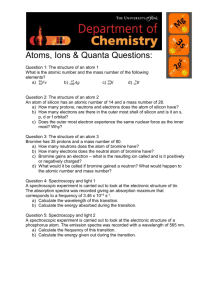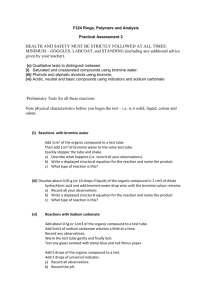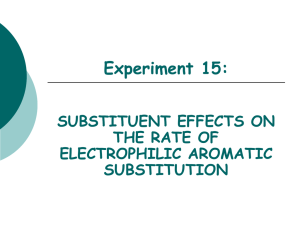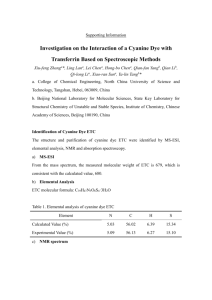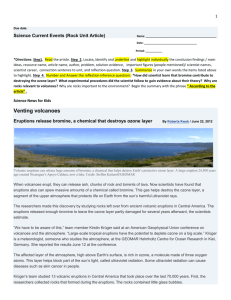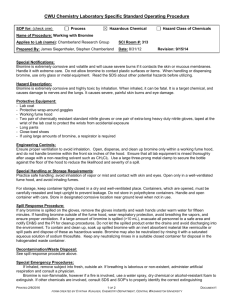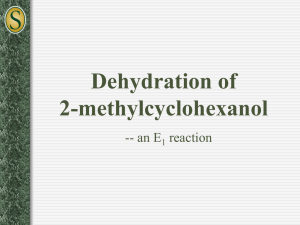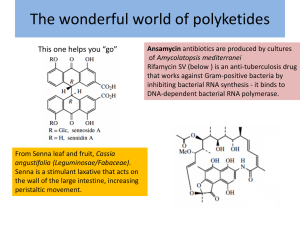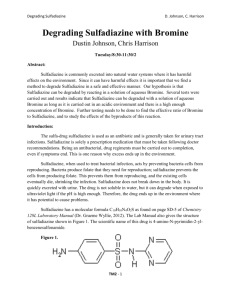Experiment 42 Reactivities of Aromatic Compounds Ashly Dowdy 3
advertisement
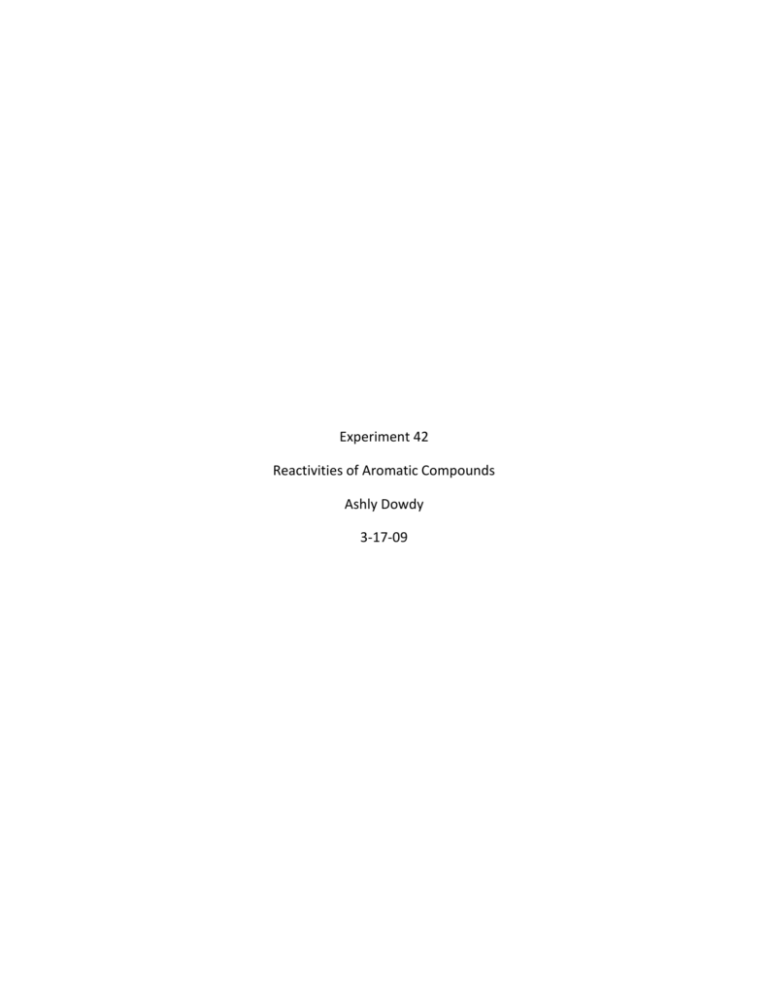
Experiment 42 Reactivities of Aromatic Compounds Ashly Dowdy 3-17-09 Abstract This experiment prepared, separated, and purified p-Bromoacetanilide with a percent yield of 33.5%. The use of NMR, GC/MS, and melting point was used to identify the product. The 13C NMR showed the expected number of carbon environments for the molecule. Proton NMR was utilized to determine that one Br atom was present due to the ratio of area for hydrogen peaks. GC/MS data showed a close 1:1 ratio between the M peak and the M+2 peak for Bromine, which indicates one bromine atom was added to the molecule. This was confirmed by the 97 quality match with N-(4-bromophenyl)-Acetamide. Also, the melting point range 165.2-168 °C matched closely to the melting point from the literature value of 168 °C for p-Bromoacetanilide. Introduction Based on this experiment, the reactivity’s of three different aromatic compounds can be distinguished. The starting materials anisole, aniline or acetanilide was added to a hydrobromic acid/bromine mixture that undergoes an electrophilic aromatic substitution reaction that adds bromine atoms to the aromatic ring. When the addition occurs, the positioning of the new atom on the ring depends on the group already present on the ring. These groups can be activators, which place new atoms at the ortho/para positions or deactivators which place new atoms at the meta position on the ring. Not only can the positioning of the new bromine be determined by the original group but also the amount of bromine atoms that are able to be added, called the reactivity. Carbon and Proton NMR and GC/MS data help illlustrate the number of bromine atoms added to the aromatic region. Based on the addition of bromine atoms the reactivity of each molecule can be ranked in relation to one another. Experimental Procedure The experimental procedure was followed on pages 347-352 in Introduction to Organic Laboratory Techniques. A drying tube was not applied to the apparatus. The amount of acetanilide that was added was 0.453 g instead of 0.45 g. The 5.0mL of bromine/hydroromic acid mixture was directly added to the claisen head. The addition of 2.5mL of unsaturated sodium bisulfate solution instead of 2.5mL of saturated was added first, then a second addition of 2.5mL of saturated sodium bisulfate solution corrected the error. Carbon and Proton NMR and GC/MS data was also collected. O H N H + Br2 N O Br Acetanilide Starting: 0.453 g 0.00335 mol Limiting Bromine p-Bromoacetanilide 15.514 g 0.194 mol Theoretical: 0.00335 mol Theoretical: 0.717 g Isolated: 0.24 g, yield of 33.5% Data Proton NMR Table Position, ppm 9.608 Splitting Pattern Singlet 7.616 7.420 Solvent Doublet Observed Area 10.81 No. of H Atoms 1 Interpretation N-H A 22.93 7.260 Doublet 22.96 3.065 2.014 Impurity- possible water Singlet 35.02 2 2 C-H on aromatic ring- closest to N-H bond B C-H on aromatic ring- closest to Br atom C 3 CH3 group connected to C=O D 1.852 Impurity Carbon NMR Table ( in 3:1 mixture of DMSO/CDCl3) Position, ppm 168.949 138.487 131.446 121.285 115.414 24.284 Interpretation C=O C connected to aromatic ring and C-N-H bond C on aromatic ring at the ortho position relative to the activating group C on aromatic ring at the meta position relative to the activating group C on aromatic ring C-Br at the para position relative to the activating group CH3 group directly connected to C=O GC/MS Table – Peak at 11.104 minutes Abudance 43 O H H H 92 H N H + 171 H N H Br 173 * Using Br79 H N Br 213/215 H * Using Br81 H N Br O * Br could be isotope 79 or 81 A F E D C B Data gathered from Reference GC/MS: Starting Material: Aniline 2,4,6-tribromobenzenamine Starting Material: Anisole 2,4-dibromo-1-methoxybenzene Results/Discussion Mechanism for Bromination: + + H Br Br-Br + O H O H N + Br + N + H H O H O H N + Br N - + H Br As multiple additions of bromine occurred, the reaction would continue using the same mechanism. The reaction would get slower due to hindrance formation as each Br was added. Proton NMR was useful when analyzing the position and number of bromine atoms present after the reaction. Based on where the Br atom is placed on the aromatic ring, the hydrogen environments will change. For example, if the –CH3 group has an area of 30 and the Br was arranged in the para position, then the total area of hydrogens on the aromatic ring would be 40. On the other hand, GC/MS better defines the number of bromine’s added to the molecule. Observing the M peak, M+2 peak, and M+4 peaks for a mass spectrum will help identify the number of bromine’s present. If there only one bromine present, the M peak and M+2 peak will be a 1:1 ratio. More than one bromine atom present will create a distinct M+4 peak in addition to the M peak and M+2. For example, the reference spectrum of 2,4-dibromo-1-methoxybenzene shows a 1:3:1 ratio between the M, M+2, and M+4 peaks. It appears that on the reference spectrum 2,4,6-tribromobenzenamine, the difference between the three peaks is less due to the addition of a third bromine atom. Reactivity: Least Most Acetanilide – Anisole - Aniline Questions: 1. The two resonance structures are shown for the amino group below. The para substitution allows for the positive charge to be delocalized onto the substituent. H H N H H H + H N H N H E H E N H 2. The least activating substituent was acetanilide. Bromination only took place once at the para position because that was the least hindered position. Appendix Attached! References: C222-2009-03-10-lmthomas-1.D\data.ms, Lauren Thomas obtained by Ashly Dowdy C222-2009-03-10-kablaney-1.D\data.ms, Katie Blaney obtained by Ashly Dowdy Calculations: Attached!
